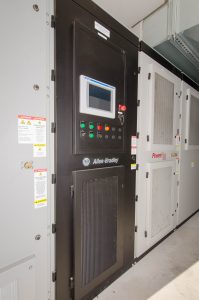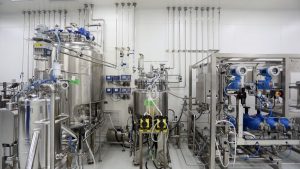
Allen-Bradley PowerFlex 7000 medium-voltage drive addresses power, start-up and operational issues at critical chemical process in The Netherlands
Background: Wilmar International Limited, founded in 1991 and headquartered in Singapore, is one of the world’s leading agribusiness groups and is ranked among the largest listed companies by market capitalisation on the Singapore Exchange.
The company’s business activities include oil palm cultivation, oilseed crushing, edible oil refining, sugar milling and refining, specialty fat, oleo chemical, biodiesel and fertiliser manufacturing and grain processing. It has over 500 manufacturing plants and an extensive distribution network and is backed by a multinational workforce of more than 90,000 people.
Wilmar’s oleo chemicals manufacturing operations has production facilities in China, Malaysia, Indonesia, The Netherlands, France and Belgium. With new facilities operating successfully in China and Indonesia, Wilmar recently introduced a new plant in The Netherlands – based on the successful format deployed in Asia – but it hit an issue when it was unable to use the primary compressor at full load on plant start-up due to limited power supply available. After reviewing various options without success, Wilmar turned to Rockwell Automation and its industry leading PowerFlex® 7000 Active Front End Direct-to-Drive™ drive.
Challenge: According to Arief Santosa, Technical Engineer at the Rotterdam plant: “At the plant we use methyl ester from palm oil to create fatty alcohols for subsequent use in the food and chemicals industry. This intermediate chemical is then sold to other parties for additional processing – such as ethoxylation – where the resulting products are eventually used in cleaning gels as a surfactant and for cosmetics.
“The methyl ester raw material goes through a high temperature, high-pressure hydrogenation process,” he continues, “which relies heavily on the performance of the compressor. After hydrogenation the product then passes through a refining/distilling process to produce the fatty alcohol end product.”
The facility in the Netherlands relies on the compressor to dictate the speed of flow and circulation of the product through the hydrogenation processes. The inability to start the compressor at full load and limitation requirements to ramp it up slowly to the required pressure had a huge impact on overall factory down-time and resulted in an inefficient production.
When the plant was being commissioned, Wilmar and the compressor manufacturer found that they were unable to start the compressor at the required 38 bar (g). “We were being forced to reduce the hydrogenation loop pressure to 15 bar (g) due to the available starting current,” Santosa explains. “At this pressure the gas compression and weight is lower, which makes it easier for the compressor to turn, but it did not suit our processing demands. We maintained this configuration for a while, but eventually we had discussions with the installer, the power company and the compressor supplier only to be told that the power from the grid there was not sufficient to start the compressor at full load. Mechanical solutions and injections systems would have consumed too much power, so at this stage, we talked with Rockwell Automation who had supplied other elements of the plant, to see if a more suitable solution was available.”
Solution: Rockwell Automation provided a class-leading Allen-Bradley PowerFlex® 7000 Active Front End Direct-to-Drive™ medium-voltage drive. Made in the company’s Katowice plant in Poland – which is currently celebrating 10 years of drive manufacturing in Europe – the flagship drive is based on the Allen-Bradley PowerFlex 7000, which has seen numerous successful installations around the world. The only current-source inverter on the market in the desired power/voltage range (3,3 kV / 50 Hz / 1,8 MW), the PowerFlex 7000 was ideal for the task at hand as it was also able to offer synchronous bypass with the compressor running at full speed.
As well as providing the necessary soft-starting capabilities to bring the compressor to full pressure much more rapidly, the drive, when fully commissioned, will also offer bypass functionality. This will allow it to be maintained even when the motor is in operation – a critical requirement for plants such as this. In operation, with the output contactor closed and the bypass contactor open, the drive operates the motor as normal. When bypass is required, the output contactor can be opened and the bypass switch closed, switching the load from a variable-frequency bus to a fixed-frequency bus. This will result in the drive input and output being isolated from the line and load voltage.
Results: For Wilmar this was a high-visibility project internally, as there was a real desire to start the whole plant under the designed conditions, mirroring the operations at the Asian plants. Therefore the commissioning and start-up was monitored as a critical performance metric.
Thanks to the PowerFlex 7000 drive, the company is now able to (soft) start the compressor at the required 38 bar (g), satisfying the needs of its process and productivity objectives. And, with the imminent implementation of the bypass functionality, the drive can literally be bypassed after it has started the compressor – with an in-rush current limited to 1 x the nominal current. As a result, practically no energy will be consumed when the drive is bypassed, so there will be minimal need for significant heat dissipation.
“The combination of the drive and the synchronous bypass has the potential to be a very robust solution for us,” explains Santosa. “We are confident that the bypass will eventually offer us additional energy savings and maintenance freedoms, but safety precautions, the high value of the equipment being driven and the demands of the production process, mean that small steps are being taken.
“The Rockwell Automation guys demonstrated impressive engineering skills and the right level of communication to give us peace of mind,” he concludes. “They were very professional and I have no issues with regards to what Rockwell Automation is doing for us. I would certainly consider Rockwell Automation for other projects in the future – due to the total support we have had to resolve any engineering issues.”
Written by Technical Lucidity on behalf of Rockwell Automation

